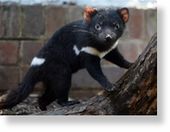
© Andre Seale / SplashdownDirect / Rex FeaturesVinaceous Amazon, a critically endangered parrot found only in the South American Atlantic Forest.
The ongoing degradation of the Amazon rainforest has obscured the plight of its smaller sibling: the Atlantic forest in Brazil, which is a biodiversity hotspot. Once covering about 1.5 million square kilometres, the rainforest has been reduced to about one-tenth of its original area in the past 500 years, a new study has shown.
The Atlantic forest supports more than 20,000 species of plants, 260 mammals, 700 birds, 200 reptiles, 280 amphibians and hundreds of unnamed species.
Unless the damage is halted, monkeys and birds unique to the region will go extinct, including iconic species such as the golden lion tamarin (
Leontopithecus rosalia) and the northern woolly spider monkey (
Brachyteles hypoxanthus), both among the most endangered of all the world's monkeys.
"Unfortunately, the forest is in very bad shape," says Jean Paul Metzger at the University of São Paulo in Brazil. "Species extinctions will occur more rapidly and, since 30 per cent of the species are endemic to the region, they will disappear forever."




